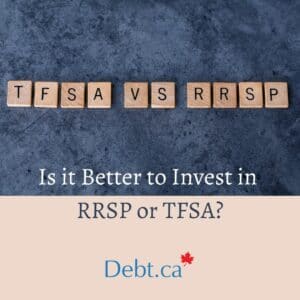A tax-free savings account (TFSA) is more than just a savings account. You can withdraw, invest, or earn interest, and that money still won’t be taxed. It’s a government-approved way to make tax-exempt money and still receive income-based benefits.
TFSAs are a simple way to increase your savings with no strings attached. All you have to do is be Canadian, 18, and have a valid social insurance number (SIN). You don’t even have to designate the savings toward anything specific like education, a car, or a home — you’re free to spend it as you’d like.
They sound a lot like their Registered Retirement Savings Plan (RRSP) counterpart, but there’s much more freedom with a TFSA: investments galore, no earned income requirement, and the ability to take out how much you want when you want.
If you’re looking to create a TFSA, or even a few (which you can), here’s everything you need to know about keeping all you can of the money you earn.
What is a tax-free savings account?
A TFSA is a savings account you can earn money from without having to cough out a penny to taxes. Depending on how you use your TFSA, it can be just a savings account or a legitimate way to reduce taxes on your investments.
Think of the TFSA like an investment bucket similar to the RRSP: You can hold different kinds of investments like cash, stocks, bonds, mutual funds, and guaranteed investment certificates.
There are three types of TFSAs, depending on who grants you one:
- Deposits
- Annuity contracts
- Arrangement in trust
The federal government created the TFSA in 2009 to encourage Canadians to save more money. It’s flexible enough to help Canadians meet both their short-term and long-term saving goals, like saving for a vacation, home, emergency fund, or retirement.
With a TFSA, you don’t have to pay income tax on any money you earn inside the account — which includes your investments. Your money grows tax-free.” However, the interest rate is lower on TFSAs compared to regular savings accounts.
Your TFSA could complement your RRSP and Registered Education Savings Plan (RESP). The TFSA is similar to the RESP because you’re investing after-tax dollars. You don’t get a tax refund for contributing, unlike the RRSP. On the other hand, you don’t have to pay income tax when you withdraw your TFSA funds.
How does a TFSA work?
You don’t want to continually be adding and withdrawing funds from your TFSA because it works differently from a regular savings account. The government designates a maximum amount you could contribute each year. This number typically floats from around $5,000 to $6,000. Always moving your TFSA money may cause you to contribute over the year’s limit and face a steep penalty tax of 1 percent per month on the over-contributed amount.
If you contribute less than a given year’s maximum, those dollars can roll over to later years.
Any money earned or withdrawn from the TFSA is tax-free. Unlike a regular savings account, you won’t receive a T5 tax slip for any money you earn or withdraw from the TFSA. You won’t need to report it on your income tax return, either. This benefits recipients of income-based support like Guaranteed Income Supplement (GIS) and Old Age Security (OAS).
If you’re a Canadian resident who is at least 18 years old, you can open and contribute to a TFSA for that year’s maximum limit. In British Columbia, Newfoundland and Labrador, Nova Scotia, and New Brunswick, You have to be at least 19 years old.
Canadians who become non-residents can withdraw from their accounts, but they can’t contribute.
What are the advantages of a TFSA?
There are several. But the biggest is that your money stays tax-free even when it’s withdrawn or invested. This lets your money grow a lot faster than it would if it were sitting in a regular savings account.
If you invest your TFSA contributions in something like stocks, your potential profit will also be tax-free. This can help you to reach financial goals like saving for a family vacation or any down payment a lot sooner — because you’re not paying income tax on your profits when you eventually withdraw your money.
If you made those investments inside a standard savings account, you’d have to pay a capital gains tax or a tax on your investment profits. Dividends inside your TFSA also aren’t subject to income tax.
Another advantage is that once you keep all of your investment profits, you can spend that money on whatever you’d like. RRSPs are strictly for retirement and RESPs for education. But with a TFSA, you can spend that money on anything: vacations, homes, investments, etc.
You can also take money out of your TFSA at any time without paying the penalty.
Unlike the RRSP, you don’t need a fixed income to create more space in your TFSA. The maximum annual contribution amount applies to all account holders, regardless of outside income.
You can see how much contribution room you have in your TFSA on your latest notice of assessment from the Canada Revenue Agency after you file your tax return.
What are the disadvantages of a TFSA?
Even though there are significant advantages to a TFSA, there is a downfall: You aren’t eligible to receive a tax refund on TFSA profit. Although, the good news is you won’t have to pay income tax when you eventually withdraw that money.
TFSAs are advantageous until you go over the contribution room limit. The penalty is a 1 percent monthly tax from the Canada Revenue Agency (CRA) for any amount you contribute over your contribution limit. You can pay the penalty or try to appeal it with the CRA. Your contribution limit resets at the beginning of each year based on your withdrawn amounts.
For example, let’s say the maximum contribution room is $5,000. If you contribute $6,000, the 1 percent penalty tax will apply to only $1,000.
Another disadvantage is that if you invest with your TFSA, you can’t claim capital losses if your investments go down in value. You can only claim capital losses, or when an asset sells for less than you paid, on non-registered accounts.
How much can you contribute to a TFSA?
Along with a contribution limit by year, your TFSA also has a contribution limit for the account overall. The federal government announces the threshold before the start of each year and can change according to inflation.
You start accumulating contribution room at 18 years old, even if you haven’t opened a TFSA. Any contribution room not used in the current year is carried forward to a future year. Likewise, you can contribute any money withdrawn from the TFSA the following year.
Be careful about withdrawing and contributing in the same year. Let’s say a given year’s contribution limit is $5,000, and you contribute the total amount — and withdraw it later in the year. Even though the account is at $0, you would have to wait until the next year to contribute the $5,000 or whatever the limit may be.
Despite the contribution limits, there’s no limit to the value of your investments inside your TFSA. For example, let’s say you contribute up to a maximum of $63,500 one year, and your investments are worth $80,000 at the end of the year.
You could withdraw the full $80,000 from your TFSA in 2019 and recontribute $80,000 plus the annual contribution limit the next year (in this scenario, it’s $6,000) for a total of $86,000 in contributions. It’s this rule that has allowed some Canadians to accumulate contribution limits of $100,000 or higher.
What’s the difference between a TFSA and RRSP?
The TFSA is a lot more flexible than the RRSP. An RRSP’s designated purpose is saving toward retirement. If you withdraw early from it, you’ll face a hefty penalty. Not only will you lose the contribution room forever, but you’ll also face withholding taxes.
Plus, you might have to pay additional taxes when filing your tax return if your marginal tax rate is higher than the withholding tax rate.
That’s not the case with a TFSA. You do not have to pay any taxes when you withdraw money, and you can withdraw at any time. The contribution room of a TFSA also resets every year and doesn’t dissolve upon withdrawal like the RRSP.
When you contribute money to your RRSP, you’ll receive a tax refund from the CRA because RRSP contributions aren’t tax-free. If you contributed $5,000 to your RRSP and your taxable income is $70,000, you’d only have to pay income tax on $65,000 after making the RRSP contribution. But with a TFSA, you won’t get an additional tax refund for contributing. That’s because you’re contributing after-tax dollars to your TFSA.
In the earlier example, your taxable income would remain $70,000. However, for both the RRSP and TFSA, your money will grow tax-free inside both tax-sheltered accounts.
RRSP Withdrawals
RRSP withdrawals also impact your eligibility for means-tested government benefits, such as (GIS) and (OAS), while the TFSA withdrawals don’t. If you’re in danger of getting your government benefits clawed back, you may be better off investing in the TFSA or using the TFSA to supplement your RRSP investments. Tax situations are personal, so it’s best to consult a tax professional.
With the RRSP, you can only have it open until the end of the calendar year of your 71st birthday. After that, you must convert it to a Registered Retirement Income Fund (RRIF), purchase an annuity or withdraw the funds. However, a TFSA can remain open as long as you’re alive.
Should you contribute to the RRSP or TFSA? It depends. If you have fewer than $50,000 in taxable income, you’re generally better off contributing to the TFSA. However, if you have $50,000 or more in taxable income, that’s when you’re usually better off contributing to the RRSP.
Speak to a trusted tax professional before deciding between the two.
Conclusion
The TFSA is a lot more than just a savings account. Understanding the rules of the TFSA can help you take full advantage and keep more of your profits.
If you’re eligible to open a one, you can open one at any Canadian financial institution that offers one. TFSAs are available at most financial institutions like banks, credit unions, insurance companies and caisses populaires (in Quebec).



